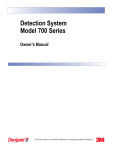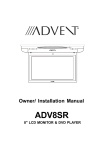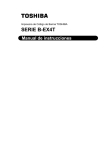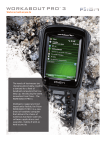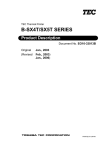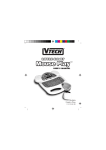Download 3M 9900 Series Oxygen Equipment User Manual
Transcript
3M™ Detection System Model 9900 Series Owner’s Manual Copyright © 2009 3M. All rights reserved. 3M™ Detection System Model 9900 Series Owner’s Manual. 78-8129-3930-0 Rev. A. 3M, Tattle-Tape, and SelfCheck are trademarks of 3M. TAGSYS is a registered trademark of TAGSYS S.A.S. All other trademarks are property of their respective owners. Contents Safety information ............................................................................................................................ 1 Intended use ................................................................................................................................... 1 Explanation of signal word consequences ......................................................................................... 1 Explanation of product safety label symbols ...................................................................................... 1 Safety messages contained in this manual........................................................................................ 1 Label locations ................................................................................................................................ 2 Regulatory compliance..................................................................................................................... 3 EMC compliance USA and Canada .................................................................................................. 3 FCC Radio Frequency Rules and Regulations ............................................................................... 3 FCC intentional radiator certification .............................................................................................. 3 Industry Canada radio frequency rules and regulations ...................................................................... 3 EMC compliance Europe ................................................................................................................. 3 Introduction ...................................................................................................................................... 4 A global leader in library system products ......................................................................................... 4 Detection system overview............................................................................................................... 5 Training your staff ............................................................................................................................ 6 Hands-on practice ........................................................................................................................... 6 Review of your library’s security policies ........................................................................................... 6 What to do when the alarm sounds................................................................................................... 6 Possible alarm scenarios ................................................................................................................. 7 Unwanted alarms ............................................................................................................................ 7 Alarm log ........................................................................................................................................ 7 System specifications ...................................................................................................................... 8 Detection zone ................................................................................................................................ 8 Power requirements ........................................................................................................................ 8 Environmental specifications ............................................................................................................ 8 Cleaning instructions ....................................................................................................................... 9 Cleaning detection lattices ............................................................................................................... 9 Photocell lens and reflector .............................................................................................................. 9 System operation............................................................................................................................ 10 Turning your system on and off ...................................................................................................... 10 Verifying system operation ............................................................................................................. 10 Patron counting ..........................................................................................................................11 Adjusting speaker volume ...............................................................................................................11 Resetting the patron counter .......................................................................................................... 12 Troubleshooting ............................................................................................................................. 13 Warranty ......................................................................................................................................... 14 Detection system alarm log ............................................................................................................ 15 3M Service ...................................................................................................................................... 16 Information to gather ..................................................................................................................... 16 3M Service phone numbers ........................................................................................................... 16 3M Library Systems Web Site ........................................................................................................ 16 Copyright © 2009 3M. All rights reserved. i Contents ii Copyright © 2009 3M. All rights reserved. Safety information Intended use The 3M™ Detection System Model 9900 Series is intended for use in detecting books and other media items marked using RFID tags that have not been checked out by library patrons. The system is typically placed at the exit point of a library such that patrons must walk through it when exiting the building or facility and provides an audio and visual alarm if unchecked materials are detected The system must be installed as specified in the 3M™ Detection System Model 9900 Series Architect’s/Contractor’s Information Package (document number 78–8129-3931-8) and is intended for use in an indoor library environment. It has not been evaluated for other uses or locations. Explanation of signal word consequences WARNING Indicates a potentially hazardous situation, which, if not avoided, could result in death or serious injury and/or property damage. CAUTION Indicates a potentially hazardous situation, which, if not avoided, may result in minor or moderate injury and/or property damage. Explanation of product safety label symbols Attention: Read accompanying documentation Risk of electric shock Safety messages contained in this manual WARNING To reduce the risks associated with hazardous voltage: • Do not use the product if the case, covers, or power cord are damaged. • Do not attempt to modify, service, or repair—no user serviceable parts inside—contact 3M Service for repair. CAUTION To reduce the risks associated with environmental contamination at the end of service life of the product: • At the end of service life, dispose of or recycle the product in accordance with applicable federal, state, and local requirements Copyright © 2009 3M. All rights reserved. 1 Safety information Label locations The following illustration shows where labels are located on the detection system lattice. • The product identification label is affixed to a metal plate inside the base of the lattice, inside the plastic lattice base cover. • For lattices distributed in the U.S., an additional product identification label is also affixed to the bottom of the lattice mounting flange. 2 Copyright © 2009 3M. All rights reserved. Regulatory compliance EMC compliance USA and Canada FCC Radio Frequency Rules and Regulations This equipment has been tested and found to comply with the limits for a Class A device, pursuant to Part 15 of the FCC Rules. These limits are designed to provide reasonable protection against harmful interference when the equipment is operated in a commercial environment. This equipment generates, uses, and can emit radiated radio frequency energy and, if not installed and used in accordance with the instruction manual, may cause harmful interference to radio communications. Operation of this equipment in a residential area is likely to cause harmful interference in which case the user will be required to correct the interference at his own expense. NO MODIFICATIONS. Modifications to this device shall not be made without the written consent of 3M Company. Unauthorized modifications may void the authority granted under Federal Communications Commission Rules permitting the operation of this device. FCC intentional radiator certification FCC ID: QHKLSP3CLEAR This equipment contains an intentional radiator approved by the FCC under the FCC ID number shown above. This device complies with Part 15 of the FCC Rules. Operation is subject to the following two conditions: (1) this device may not cause harmful interference, and (2) this device must accept any interference received, including interference that may cause undesired operation. Industry Canada radio frequency rules and regulations This Class A digital apparatus meets all requirements of the Canadian Interference-Causing Equipment Regulations. Cet appareil numerique de la classe A respecte toutes les exigences do Reglement sur le materiel brouilleur du Canada. CANADA: 7562A-LSP3CLEAR Operation is subject to the following two conditions: (1) this device may not cause interference, and (2) this device must accept any interference received, including interference that may cause undesired operation of the device. EMC compliance Europe This equipment meets the requirements of the RTTE and EMC directives. Copyright © 2009 3M. All rights reserved. 3 Introduction A global leader in library system products 3M pioneered the concept of electronic protection of library materials more than 35 years ago. We are still leading the way. Today, thousands of libraries around the world use 3M detection systems to protect their valuable collections. What this means to you From our field service organization to our technical service group and customer support staff, we are committed to providing you with the support you require to help ensure your satisfaction. The system has been designed to detect the unauthorized removal of materials concealed within book bags, briefcases, or under clothing. While a 100% electronic net does not exist, the system provides effective protection and significant reduction in the loss of library materials. With a little attention and care, your system should provide you with many years of service and help to protect your library against thousands of dollars in losses. Call our toll free 800 number any time of the day or night for service, to order supplies, or to contact your sales representative at 1-800-328-0067. Figure 1 3M™ Detection System Model 9900 Series 4 Copyright © 2009 3M. All rights reserved. Introduction Detection system overview The 3M™ Detection System Model 9900 Series works by detecting RFID tags in books or other media items and reading their secured or unsecured status. The system detects secured ISO 15693 RFID tags such as 3M™ Basic and Premium RFID tags. The system is typically placed at the exit point of a library such that patrons must walk through it when exiting the building or facility and it provides an audio and visual alarm if materials that have not been unsecured are detected. The 3M™ Detection System Model 9900 Series is compatible with optional 3M™ Stats & Status Software for 3M™ Detection System Model 8900–9900 Series from which system alarm and patron counting information can be viewed and reports can be generated if desired. Copyright © 2009 3M. All rights reserved. 5 Training your staff A key element of any media loss prevention effort is a successful staff training program. Your system will be much more effective with the active cooperation and participation of your entire library staff. We recommend that you periodically conduct formal training sessions, including the following elements to help ensure its success. • Reviewing the owner’s manual • Practice tagging materials with 3M™ RFID Tags • Reviewing your library’s security policies • Reviewing how to respond when the alarm sounds • Using the system alarm log • Addressing patron concerns Hands-on practice After reviewing this manual, your staff will benefit from actual hands-on experience with the detection system products they are expected to use. We suggest you start by demonstrating the proper techniques for each tagging procedure. You may wish to conduct the actual practice as follows: 1. Make sure that all the other 3M Library Systems products are installed and functional. 2. Let each staff member practice installing the tags on library items. 3. Let each staff member practice securing and unsecuring materials. Review of your library’s security policies Before practicing how to respond to alarms, staff should be familiar with the library’s security policies as they relate to theft of materials. It is important that staff become familiar with state and local laws governing patron’s rights and responsibilities, and the response should be consistent for all patrons caught in an alarm. To help staff stay informed of security measures, your policy should be in writing and kept with your training kit along with any other procedures you follow. Note: It is particularly important for staff members to know what procedures the library follows when theft is suspected or when it is necessary to contact a local law enforcement agency. A critical phase of staff training concerns the proper steps to take when the security system alarm sounds. The value of tact and courtesy when handling this delicate situation cannot be overemphasized. Your staff members should receive as much preparation as possible to make them feel comfortable. With the proper training, your staff will be more likely to effectively deal with patrons who activate the alarm. Responding to alarms can be a sensitive situation but can also be handled confidently and effectively as long as your library has established procedures and your staff members are fully trained in following them. What to do when the alarm sounds Generally, remain calm and courteous. Don’t panic and don’t rush to assumptions about the person who triggered the alarm. It’s not possible to be immediately certain of the thoughts or motives of the person. Never accuse anyone of theft by word, by facial expression, or by tone of voice. In rare occasions, the alarm may have triggered falsely. In other cases, an item may not have been 6 Copyright © 2009 3M. All rights reserved. Training your staff unsecured properly, or the person holding the item that caused the alarm may not even be aware it is in their possession. Always respond in a positive, nonthreatening manner. Possible alarm scenarios In simple terms, a patron might respond to a triggered alarm in either of three ways: 1. The patron might stop in the corridor. 2. The patron might be unaware they have caused the alarm, disregard it, and casually continue to exit. 3. The patron might run for the exit. In the third scenario, the answer is obvious: follow your library’s policy for theft. The solution for the first and second scenarios may not be so clear-cut and you will want to exercise courtesy and tact because you will want the patron’s cooperation and in most cases the patron will want to cooperate. After asking the patron to return to the counter, you might typically ask “Excuse me, did I forget to check out one of your items?” or “Did you perhaps pick up one of the library’s books with your own things?” These are courteous questions and they don’t accuse the patron of theft. Be sure to smile and ask the questions in a friendly, nonthreatening manner. Process and unsecure all items again. If you discover an item that hasn’t been properly checked out, never accuse the patron of stealing. Simply act as if the error was an oversight—it more than likely was—and you can resolve the situation easily in this manner. If the patron is uncooperative or causes the alarm to sound again, follow the policy that your library has established for possible theft of materials. Unwanted alarms Your detection system is virtually free of false alarms. Occasionally your system may alarm and your staff may find that the patron does not have unauthorized library materials. Unwanted alarms may be caused by tags on items carried into the library such as books from another library. Unwanted alarms are generally infrequent and will vary depending on the patrons and the proximity of your library to facilities that are releasing items containing tags. Because it is not possible to distinguish between unwanted alarms and alarms with potential item loss, all responses to alarms must be consistent and follow your management policies. If patrons see no response to alarms, the system becomes less effective. When you decide that a tag on an item from outside your library caused an alarm, follow these steps. 1. Explain the problem to the patron. 2. Verify that all of the patron’s library materials are properly checked out. 3. Allow the patron to exit the library. Many patrons will learn from the experience and will not carry items that may cause alarms into the library. Alarm log The alarm log is used to keep a record of details involving alarms that occur. See the Detection system alarm log form on page 15. For each alarm, record the information in the log. Keeping this log up-to-date provides a key tool for monitoring system activity. An up-to-date alarm log provides useful information for library management and your 3M service representative. Tip: If patron count is a concern, use the Alarm log frequently to record patron count. The patron counter on each lattice is backed up by battery power so it will not reset to zero anytime power to the system is shut off, disconnected, or otherwise interrupted (for example, a power outage). For more information about patron counting, see Patron counting on page 11. Copyright © 2009 3M. All rights reserved. 7 System specifications Detection zone The primary zone of detection between detection lattices extends from 6 in. [15 cm] above the surface of the floor to 72 in. [1,82 m] above the floor. The electronic coverage in this zone is not 100%; however, the rate of detection is effective to deter the loss of protected materials. It is also important to watch for suspicious actions such as holding materials above or outside of the detection lattices when passing through the system. Power requirements System power input for all systems (RMS) is: 100-240 V AC 50/60 Hz. Internal consumption of 500 mA, 2000 mA output max., 2500 mA max. Total. Fuse on AC: Schurter FST 5 × 20 mm, Time-lag T, H, 250 V AC, 500 mA. Fuse on DC supply: Schurter SPT, 5 × 20 mm, Time-Lag, T, H, 300 V DC, 2 A Maximum power requirements for each detection lattice is 25 W. Maximum power requirements for each system are as follows: • Model 9901 (Single corridor system, 2 lattices): 50 W. • Model 9902 (Dual corridor system, 3 lattices) 75 W. • Model 9903 (Three corridor system, 4 lattices) 100 W. • Model 9904 (Four corridor system, 5 lattices) 125 W. Power cord: 18 gauge, 3-wire, S-rating, 9.74 feet [3,0 m] long, NEMA 5-15P plug, with an IEC 320 connector. Electrical outlet: an electrical outlet is required within reach of the system power cord. • A dedicated circuit is not required but is recommended to prevent overloading and loss of security. • Circuit loading must not exceed 50% of the rated circuit current to help ensure voltage stability. WARNING To reduce the risks associated with hazardous voltage: • Do not use the product if the case, covers, or power cord are damaged. • Do not attempt to modify, service, or repair—no user serviceable parts inside—contact 3M Service for repair. Environmental specifications Operating temperature range: 32° F [0° C] to 104° F [50° C]. Storage temperature range: -4° F [-20° C] to 140° F [60° C]. Humidity 0% to 85% relative humidity, non-condensing. CAUTION To reduce the risks associated with environmental contamination at the end of service life of the product: • At the end of service life, dispose of or recycle the product in accordance with applicable federal, state, and local requirements. 8 Copyright © 2009 3M. All rights reserved. Cleaning instructions Figure 2 3M™ Detection System Model 9900 Series cleaning Cleaning detection lattices CAUTION Turn off/unplug the detection system before using liquid cleaners and take care to not allow liquid into the lattice base, as this can damage the system electronics. Do not use harsh chemicals, cleaning solvents, or strong detergents, which may warp, discolor, craze, or otherwise damage lattices — particularly the large clear panels. Use a damp soft clean cloth or chamois to gently clean lattices. Dirt particles or excessive pressure can scratch the lattice panels. If surfaces become soiled, clean the affected area with a cloth moistened with a solution of mild soap or detergent and lukewarm water. Rinse with clean water and dry any residual moisture with a clean, dry soft cloth or towel. Several antistatic cleaners for acrylic are available to reduce static electricity and dust attraction. Wiping with a soft damp cloth or chamois is all that is necessary to keep the clear lattice panels dust free between application of these cleaners. Do not use window cleaning sprays, kitchen scouring compounds, or solvents such as ammonia, alcohol, turpentine, paint thinner, or lacquer thinner. Photocell lens and reflector At least once a month, wipe the photocell lens and reflector with a soft cloth dampened with water or diluted mild soap or detergent solution as described above. Copyright © 2009 3M. All rights reserved. 9 System operation Turning your system on and off There are two possible methods of powering the system: Figure 3 Detection lattice with AC power cord • The system may be hard-wired into the power distribution panel of the facility’s electrical system, in which case, the system is switched on or off at a power disconnect switch or at the circuit-breaker for the circuit that supplies power to it. • The system may be equipped with an AC power cord (or two AC power cords, one at each end of the detection system), in which case the system is on while power cord(s) are connected to live power outlet(s) and off when power is disconnected. In the second case, the system can of course also be switched on or off at the circuit breaker for AC power outlet(s) to which the system is connected. Note: If the detection system is connected to power at both ends, you must connect or disconnect power at both ends of the system. Verifying system operation Your system should be inspected daily for proper operation. To verify the system, walk through the system corridor with a secured library item. This should result in an audible alarm and flashing alarm lights in the detection lattices. There is no need for repetitive walk-through testing. During normal operation, the current patron count is displayed. Walking through each corridor should increment the patron counter as expected, depending on how patron counting is configured (by the technician) for the system. • If patron counting is configured to count patrons as they enter, the patron count should increment the patron count by one as you enter and not increment as you exit through the corridor. • If patron counting is configured to count patrons as they exit, the patron count should not increment as you enter, but it should increment by one as you exit through the corridor. • If patron counting is configured to count patrons as they enter and exit, the patron count should increment by one as you enter through the corridor, and then increment by one again as you exit through the corridor. All lattices in the system should be configured to count patrons in the same way. If the detection system is to be used with the optional 3M™ Stats & Status Software for 3M™ Detection System Model 8900–9900 Series, the patron counting method should be both. 10 Copyright © 2009 3M. All rights reserved. System operation Patron counting A patron counter is mounted on each lattice. Each patron counter will increment only for the corridor it is facing. Since there is always one more lattice than there are corridors, the patron counter facing out, away from the system, will under normal circumstances always have a zero patron count. Patron counting is set by the technician at installation to either • Count patrons as they enter through a corridor • Count patrons as they exit through a corridor • Count patrons as they enter and count patrons as they exit through a corridor Each patron counter counts independently. There is not a display for a total running count of all corridors for the system for 2–, 3–, or 4–corridor systems. For a total patron count for multiple-corridor systems, you will need to record and add together the patron counts on the individual patron counters. If the system is configured to count patrons as they enter and as they exit, you will need to divide this total in half, as the system is, in effect, counting each patron twice (once as they enter, and then once as they exit). Each patron counter is backed up by battery power so it will not reset to zero anytime power to the system is shut off, disconnected, or otherwise interrupted (for example, a power outage). Adjusting speaker volume Each lattice has a speaker inside its base that will make the alarm sound if an alarm condition occurs. If the alarm is too loud or too soft, the volume may be adjusted manually. Note: To adjust the speaker volume, you will need a small (4 mm [0.16 in.] maximum diameter) flat blade screwdriver. To adjust speaker volume 1. Locate the speaker volume adjustment knob inside the opening for the speaker in the lattice base cover, next to the speaker. 2. Use the small (4 mm [0.16 in.] maximum diameter) flat blade screwdriver in the adjustment knob slot to turn the speaker volume up or down to the desired level. Figure 4 Speaker volume adjustment Tip: Use a secured book to trigger the alarm so you can hear it as you adjust the volume. Note: Adjusting the volume may also affect the frequency (pitch) of the alarm sound. 3. Confirm that the alarm can be heard and is set to a volume level that is effective and appropriate for the library. 4. Repeat for each lattice. Copyright © 2009 3M. All rights reserved. 11 System operation Resetting the patron counter Note: This procedure explains how to reset the patron count that is displayed externally at each lattice on the LED screen next to the photocell lens. This is different from the patron count that each lattice maintains internally and appears in the 3M™ Stats & Status Software for 3M™ Detection System Model 8900–9900 Series. For information about the internal patron count, refer to the 3M™ Stats & Status Software for 3M™ Detection System Model 8900–9900 Series Administrator’s Guide. The following procedure provides a way to reset the patron count displayed in the patron counter window of each lattice. Tip: To keep track of the total patron count, record the number displayed in the patron counter display window before resetting the patron counter. To reset the patron counter 1. Locate the access hole for the reset button, next to the patron counter window. 2. Partially straighten a paperclip. 3. Gently push the paperclip straight into the access hole, approximately 1/4 in [6 mm] until the reset button clicks, and then remove the paperclip. Figure 5 Use a paperclip to reset the patron counter Tip: Direct the paperclip straight into the hole to contact the reset button. 4. Confirm that the patron count displayed has been reset to zero. 5. Repeat for each lattice. 12 Copyright © 2009 3M. All rights reserved. Troubleshooting Problem Cause Action No alarm, no patron count Unit not plugged in to power outlet Make sure the unit is plugged in; wait 10 seconds for full operation. Circuit breaker off Reset facility circuit breaker; wait 10 seconds for full operation. No alarm Tag unsecured Test system with another library item known to have a secured tag. Infrequent unwanted alarms Protected material from another library Identify material that caused the alarm. Failure to unsecure tags properly Follow correct checkout procedures outlined in 3M literature. Check operator training procedures. Failure to unsecure tags properly Follow correct checkout procedures outlined in 3M literature. Check operator training procedures. System failure Place service call to 3M. Metallic objects too close to the system Remove the object and maintain a distance of 31.5 in. (80 cm) from the detection system lattices. Books not properly secured Retest with a properly secured book. System failure Place a service call to 3M. Incomplete walk through test Retest by walking through the corridor. The light beam between the photocell and the reflector in the corridor must be interrupted to increment the patron counter. Patron counting is configured for counting in the other direction (for example, exiting instead of entering) Retest by walking through the corridor in the opposite direction. System failure Place a service call to 3M. Patron count too high or too low Patron counting is configured differently than expected. See Patron counting on page 11. Retest to verify patron counting is configured correctly for your library and the system orientation.* In a multiple-corridor installation, some lattices seem to be working while other lattices do not Power to only part of the detection system For detection systems with more than four corridors, both ends of detection system must be connected to power. Frequent (daily) unwanted alarms Reduced coverage, no alarm Patron counter did not increment * Patron counting direction (or whether patrons are counted entering and exiting) must be configured by a 3M trained technician. Copyright © 2009 3M. All rights reserved. 13 Warranty Effective 12-12-05 One Year Library Systems Product Performance Guarantee: Subject to the Limitation of Liability below, 3M guarantees your satisfaction with the performance of any 3M Library System Product for 12 months from the date of installation provided that a) you are the original purchaser: b) you have executed a one (1) year 3M Service Agreement for maintenance of the Library System product; and c) the product has not been subjected to abuse, misuse, accident or neglect. Performance means the product meets 3M published product specifications. If you are not completely satisfied with the performance of your Library System Product, you may return the Library System product for a prompt refund. 3M will pay all reasonable de-installation and shipping charges to return the product to 3M. Note that all claims under this guarantee must be submitted to 3M within 12 months from the date of installation of the 3M Library Systems Product. Failure to submit a claim within this time frame will invalidate this guarantee. IMPORTANT: Consumables and non-3M branded products are excluded from this Guarantee. Warranty and Limited Remedy for Non-Software Library Systems Products Not Covered by Performance Guarantee: Unless stated otherwise in 3M product literature or packaging, 3M warrants that each 3M Library Systems Product meets the applicable specifications for a period of ninety (90) days from the date of shipment (or, in the case of hardware installed by 3M, from the date of installation). Any warranties related to 3M software are contained in separate 3M software licenses. Consumables and non-3M branded products are excluded from this Warranty and Limited Remedy. 3M MAKES NO OTHER GUARANTEES, WARRANTIES OR CONDITIONS, EXPRESS OR IMPLIED, INCLUDING, BUT NOT LIMITED TO, ANY IMPLIED WARRANTY OR CONDITION OF MERCHANTABILITY OR FITNESS FOR A PARTICULAR PURPOSE OR ANY IMPLIED WARRANTY OR CONDITION ARISING OUT OF A COURSE OF DEALING, CUSTOM OR USAGE OF TRADE. You are responsible for determining whether the 3M product is fit for a particular purpose and suitable for your application. If the 3M product is defective within the warranty period and provided that a) the product has not been subjected to abuse, misuse, accident or neglect and b) you have notified 3M within thirty (30) days after the defect was discovered, your exclusive remedy and 3M’s and seller’s sole obligation will be, at 3M’s option, to replace or repair the defective 3M product. Limitation of Liability: EXCEPT WHERE PROHIBITED BY LAW, 3M AND SELLER WILL NOT BE LIABLE FOR ANY LOSS OR DAMAGE ARISING FROM 3M LIBRARY SYSTEMs, WHETHER DIRECT, INDIRECT, SPECIAL, INCIDENTAL OR CONSEQUENTIAL, REGARDLESS OF THE LEGAL THEORY ASSERTED, INCLUDING WARRANTY, CONTRACT, NEGLIGENCE OR STRICT LIABILITY. Guarantee and Warranty Claims: For guarantee and warranty claims, and for service, contact our service representatives at 1-800-328-0067 Track and Trace Solutions 3M Center Building 225-4N-14 St. Paul, MN 55144-1000 14 Ver121205 Copyright © 2009 3M. All rights reserved. Detection system alarm log Alarm Date Time Patron count Reported by Alarm reason* (1–5) $ Value of recovered materials Description of recovered materials *Alarm reason: 1. Test 2. Upon entering 3. Failure to un-secure 4. Undetermined 5. Real alarm Copyright © 2009 3M. All rights reserved. 15 3M Service Information to gather Before you call for service, please have following information available: • The name, address, and telephone number of your facility • A description of the problem or the issue you want addressed • The model number and serial number of the equipment (located on the serial label), if the call is in regard to a system problem Model Number _________________________ Serial Number _________________________ 3M Service phone numbers For questions regarding your system, call one of the following numbers. In the United States In Canada In other countries 1-800-328-0067 English 1-800-268-6235 Français 1-800-567-3193 Call your local 3M office. 3M Library Systems Web Site The 3M Library Systems Web site can be located at http://www.3M.com/library. For additional information in the United States about 3M Library Systems, go to http://www.3M.com/us/library. 16 Copyright © 2009 3M. All rights reserved. 3M Library Systems 3M Center, Building 225-4N-14 St. Paul, MN 55144-1000 www.3M.com/library























